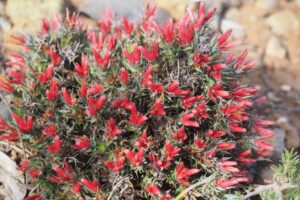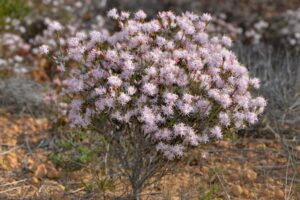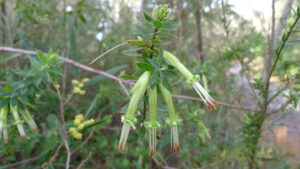
Epacrids under cultivation: A growing challenge
By the Australian Plants Society (Victoria) Mornington Peninsula District Group
Held biennially by the Australian Plants Society Victoria (APS Victoria), the FJC Rogers Seminars provide an opportunity for native plant lovers of all knowledge levels to come together to focus on one plant group. The Mornington Peninsula District Group organised the 15th such seminar in August focusing on the Epacridoideae sub-family of the Ericaceae, a group otherwise known as epacrids, which remain under-represented in cultivation. This event provided an occasion for members of the wider horticultural community to share their tips for the propagation of this unique group of plants.
The epacrids were known as their own family, Epacridaceae, up until 2002, when they were then grouped into a sub-family of the (nearly) world-wide family Ericaceae, as genetic research showed that these plants all had a common ancestor. One possible classification of the resulting heath or heather family includes nine subfamilies, 126 genera, and about 4,000 species. The majority of Ericaceae subfamilies and species occur outside of Australia, e.g., cranberry, blueberry, huckleberry, various common heaths and heathers, and rhododendron (including azaleas), except that two Rhododendron species are endemic to Australia.
Epacris is the largest, and probably the most familiar, of the 32 genera in the epacrid subfamily. Almost 40 species are distributed from southeast Queensland down the eastern seaboard of Australia to Tasmania, South Australia and across to southwest Australia. Epacris impressa (common heath) is the Victorian State Floral emblem.

The epacrids are not showstopper plants. Their beauty is in their delicacy; tiny flowers strung in clusters from often straggly stems. However, they are fiendishly difficult to cultivate. Demand for most epacrids is low due to their limited occurrence in most bushland areas, along with potential buyers accepting they are unlikely to obtain stock, or that it will survive. Members of the International Plant Propagators Society (IPPS) have trialled various techniques to propagate species from this family with varying results as outlined below.
David Hancock, Natural Area, Malaga, WA
Our focus for over 20 years has been on difficult-to-grow Western Australian species where demand is strong for revegetation and restoration. We have had many successes growing Asteraceae, Proteaceae, Cyperaceae, Dasypogonaceae, Santalaceae, Poaceae and other species. Much of this success has been achieved due to sourcing quality seed, often from in-house collections, knowing what quality seed looks like and continuous experimentation with treatment methods, often radical.
One standout for us has been Brachyloma preissii (globe heath), initially courtesy of collection of its seeds from emu poo. We clean the seed before germination treatment. We have achieved germination rates of up to 60% using a combination of sulphuric acid, smoked water, and gibberellic acid in mixed treatments. This combination is also producing good results for Acrotriche cordata (coast ground-berry) from quality seed. Scarification of this species’ seed has provided no response.

We have also achieved success with Styphelia propinqua and Leucopogon insularis (beard heath) using similar treatments. Results are variable due to seed quality. Our latest sowing of L. insularis at 11g resulted in germination of 50 plants in three days post treatment. Other seed location results were much poorer. Leucopogon parviflorus (coast beard-heath) generally works well for us.
From our ongoing trials and experiences with epacrids, the following general observations and techniques have emerged:
- X-ray of various epacrids suggests embryo presence at no better than an average of 12%.
- Dark, well-formed seed produces best results, lighter coloured seed much less so.
- Our trials with hydrogen peroxide gave no success with epacrids. We have had favourable experience with some species within the Poaceae, Cyperaceae and Sapindaceae.
- Weathering of seed is also worth considering and we are happy to share how we do this for various species (e.g. Dianella, Hibbertia, Lepidosperma).
- Root disturbance gives adverse outcomes. It was suggested by Dermot Molloy, Senior Curator at the Royal Botanic Gardens Victoria, that direct sowing to a cell tray or tubes could assist.
- Our experience is that epacrids are preferred food for rats and mice.
It is only recently, having managed success with many other species considered difficult, that we will focus more on epacrids, particularly Conostephium pendulum (pearl flower).
Michelle Haby, botanist & grower, Kangaroo Island, SA
I have had good success germinating Styphelia humifusa(cranberry heath) in the past, but I cannot keep them alive much past germination. The best treatment is to soak seed in a mild bleach solution for 30 minutes, before placing it in a snap lock bag with moist sawdust. Then place the seed in a cool dark place (I put mine in the laundry cupboard). I obtained a 55% germination rate using this method with one- to two-year-old seed that I sowed in April, with germination occurring in June.
I got 0% germination using the same method with Stenanthera conostephioides (flame heath), but maybe that is unsurprising as back when I did this, they were both called Astroloma. While I have had limited success germinating this species, they usually stay alive once they are germinated.
I usually have good success with Leucopogon parviflorus, particularly if you sow seed that has passed through a bird’s gut. I am going to try Epacris impressathis season as I have finally gotten some seed. My friend says that he had good success using gibberellic acid at a concentration of around 1000 milligrams per litre.

I am slightly obsessed with Acrotriche depressa (native currant) and have thrown every treatment known to man at it; however, with limited success. Leaching for three weeks in my toilet cistern seemed to be the common thread for this one. There was no real difference between what else I used on this seed after I leached them. They are a winter germinator regardless of when you sow them.
Plants of Tasmania Nursery, Ridgeway, TAS
The most effective propagation method for our Epacris spp. is through softwood cuttings. The best cuttings are taken from areas where there is a noticeable colour transition in the stem, as these tend to root more successfully. Semi-hardwood cuttings can also be used, but they generally take longer to develop roots. The ideal time to take cuttings is either before or after the flowering period, with spring being the most suitable season.
Once cuttings are prepared, they require a suitable propagation media to promote root formation. Different species exhibit varying degrees of success depending on the media used. For example, Epacris impressa was trialled in both Jiffy plugs and cutting mix. While both methods took approximately 12 weeks for root development, the success rate differed significantly. Cuttings in the standard cutting mix exhibited a higher success rate, whereas those in Jiffy plugs had only a 10% success rate. This lower success was likely due to the use of hardwood cuttings. Other Epacris species, such as E. graniticola, E. gunnii, E. lanuginosa, E. mucronata, E. myrtifolia, E. paludosa, and E. serpyllifolia, tend to root more easily than E. impressa and generally strike well in a standard cutting mix.
Once the roots have developed sufficiently, transplanting must be done with great care to avoid disturbing the delicate root system. Root disturbance can significantly impact the plant’s ability to establish in its new container. Despite careful handling, a loss rate of 10-20% is expected after potting up. Ensuring proper environmental conditions, such as consistent moisture and humidity, can help reduce transplant shock and improve overall survival rates.
Ben & Anouska Croxford, Nuts about Natives, Karnup, WA
We have had reasonable success growing several species of Andersonia from seed which germinates and grows reasonably well, but more recently these have mainly been rare species in which seed was germinated in vitro and supplied to us as a germinated seed on agar which we potted up and grew on with good success.
For species with large fruit and hard seeds, we have had limited and inconsistent success by sowing seeds and either just leaving them in the nursery for multiple years (always wet) or removing them from irrigation over summer and irrigating once a month and returning them to nursery conditions in autumn. The best success we have had has been with Leucopogon australis (spike beard-heath), Leucopogon capitellatus, and Brachyloma preissii, with limited germination in other Leucopogon and Styphelia species.

We have grown many more species by cuttings including Acrotriche cordata, Leucopogon parviflorus, Styphelia propinqua, S. conostephioides and Conostephium preissii. Probably the most successful cutting-grown species for us is S. conostephiodies which strikes okay and then grows well in the nursery. Most other species we have found to be slow-growing as tubestock with relatively poor root growth, and in many cases are best held for two seasons, repotting in between.
FJC Rogers Seminar
At this year’s FJC Rogers Seminar, several keynote speakers presented further on the topic of epacrid propagation. Peter Cooley, Chief Executive Officer of Indigigrow in New South Wales spoke about ‘Success in propagation and cultivation of Styphelia viridis’. James Wood, Seed Bank Manager at the Royal Tasmanian Botanical Gardens, presented on ‘Germinating wild epacrid seed – successes and failures.’ Professor Kingsley Dixon’s ‘Myths, magic and what’s missing in the germination of Australian Ericaceae’ described his ‘41-year journey of some discoveries’, including his latest results using 3D tomography.
A discussion panel of local growers, together with Peter Cooley and David Hancock, described their experiences propagating epacrids. The speakers described similar problems to those described above by IPPS members above. The consensus was that commercial and volunteer propagation of their local species was most successful from cuttings.
Proposed Study Group
If there is enough interest in sharing knowledge, progress and avoiding more entries in the ‘journal of zero outcomes’ (to quote Professor Dixon), it is proposed that an Australian Native Plants Society Australia (ANSPA) Study Group for Epacrids be formed to become a central information exchange, particularly for breakthroughs in both propagation and cultivation. Expressions of interest in such a study group, or some other form of central and other communication, can be directed to epacrids2025@gmail.com.
Further information
The presentations, newsletters and final report from the FJC Rogers Seminar will be available for viewing late September on the APS Victoria website: www.apsvic.org.au/fjc-rogers-seminar-2025/
Newsletters of the closed ANPSA Epacris Study Group (1992 to 2025) can be viewed here: https://anpsa.org.au/study_group/epacris-study-group/
Australian Plants Society (Victoria) Mornington Peninsula District Group
E: epacrids2025@gmail.com
